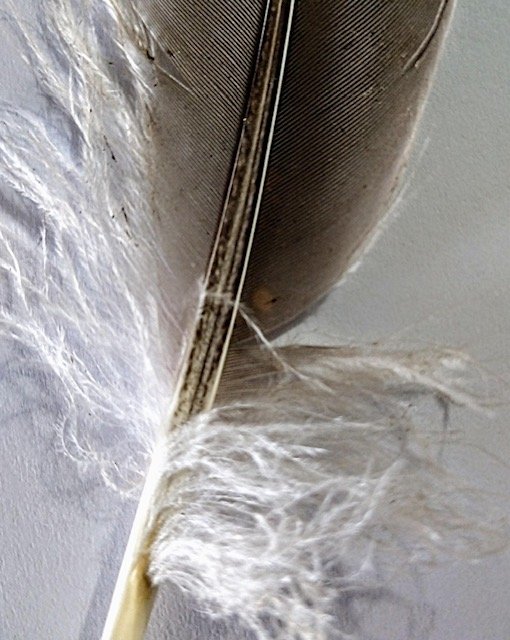Feathers
By Les Braund
For me, the most enjoyable event of the year in Los Peñasquitos Canyon is the Arch in the Park. Each year, archaeologists, colleges, government agencies, and businesses gather to display the findings from in and around San Diego County. On their tables are artifacts such as pottery shards, bones, stone tools, books and more. Several years ago, one of the vendors had a book titled Bird Feathers: A Guide to North American Species. The book was written by Casey McFarland and S. David Scott. Both are experienced trackers. Soon I obtained a copy.
After I obtained that copy, I started collecting a few feathers. The first feathers I found were a pair of yellow and tan fuzzy feathers about two inches long.
Common Poorwill feathers
Photo by Fred Buenavista
The book consists mostly of pictures of bird feathers laid out illustrating the various feathers common to that species. Looking through the book I soon found a match. The feathers were from a Common Poorwill, Phalaenoptilus nuttalii. Until I found these feathers, I didn’t know that Common Poorwills were found in the canyon.
The feathers I found are called contour feathers. These are the feathers that create the contour of the bird. There are many other kinds of feathers. All of the feathers visible on the exterior bird are water proof and wind proof. The construction of the feathers demonstrates why. Feathers are made of keratin just like our fingernails.
Parts of Feathers
Parts of Feathers
There are numerous parts of feathers.
Types of Feathers
Types of feathers
There are numerous types of feathers.
Flight feathers are the most useful for identifying what bird the feather came from. There are two types of flight feathers: primary and secondary. Primary feathers are the feathers that occur at the tip of the wing. The tip of the wing is the equivalent of our hand. The secondary feathers instead appear on the equivalent of our forearm. Primary feathers are generally more pointed than secondary feathers and they are generally the longest feather the bird has. There are exceptions like peacocks which have exceptionally long tail feathers. Secondary feathers are shorter and more round at the ends and the inner and outer vanes are nearly equal on both sides of the rachis. Most birds have ten to twelve flight feathers
Primary and Secondary Flight Feathers
Primary feathers pull the bird through the air while secondary feathers provide most of the lift. Some large soaring birds like hawks, vultures, and eagles have fingers at the ends of the wings. When this occurs, it is called slotting.
Juvenile Red Tailed Hawk with “fingers” at the end of the wings
Photo by George Adkins
These are specialized primary feathers. These feathers aid in soaring by creating more lift. These feathers are often tapered and notched a condition referred to as emargination.
Notched and glazed goose feather
Photo by Fred Buenavista
The shaft of flight feathers or the rachis actually is square with a grove on the underside which adds strength to the feathers so they don’t bend during flight.
Underside of a flight feather showing the grooved rachis
Photo by Fred Buenavista
The leading edge of the flight feathers is narrower than the trailing edge. The leading edge and slight curvature of the flight feather can be used to determine which side of the bird the feather came from.
Flight feathers of heavier birds, such as ducks and geese, are unique due to the tightly over lapped barbs that form a glaze on the underside of the feather which adds strength and prevents the feather from separating while in flight.
Owl feathers are designed to allow quiet flight due to the vanes on the leading edge of the flight feathers being furred.
Owl flight feather. Closeup picture shows “furred” leading edge.
Photo by Fred Buenavista
An interesting bit of history is that the Constitution was written using a quill pen of either a goose feather or a turkey feather.
Contour feathers cover most of the body. They are shorter than flight feathers and are bilaterally symmetrical. As the word implies contour feathers give the bird its shape. Countour feathers grow on the bird like roof shingles forming a water proof barrier and providing a layer of insulation.
Semiplume feathers lack barbicels (hooks) to hold the feather together, thus they are important for insulation. They also provide a thick layer for the contour feather to build upon.
Down feathers vanes are short or lacking. The barbs lack hooks to maintain organization thus the feather is fluffy allowing for superior insulation.
Filoplume feathers are quite simple. These feathers are located under the contour feathers and are believed to detect movement or vibrations similar to whiskers on a dog or cat. They also may aid in determining air speed. These feathers have a shaft that is mostly bare, with barbs only near the end.
Bristle feathers are the opposite. The tip of the shaft lacks barbs but near the quill there are barbs. These feathers are found around the eyes and neck of birds. For some birds like wood peckers, these feathers prevent woodchips from getting in their eyes.
One additional feather I would like to mention - tail feathers, particularly those of woodpeckers. Woodpeckers use their tail feathers for support while pecking at a tree to seek food or create cavities. The ends of their tail feathers often show the most physical damage as a result.








